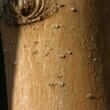Background
- Phlorizin, also known as phloridzin, is a compound found in several fruit trees, including apple and cherry, and the bark of pear trees.
- Experts have suggested that phlorizin may block glucose (sugar) absorption from the intestines and increase glucose loss in the urine.
- Phlorizin and its analogs (similar chemical compounds) are being investigated for the treatment of diabetes, obesity, and stress hyperglycemia (high blood sugar levels). At this time, clinical studies investigating effects of phlorizin are lacking.
References
- Andlauer, W., Kolb, J., and Furst, P. Phloridzin improves absorption of genistin in isolated rat small intestine. Clin.Nutr. 2004;23(5):989-995. View Abstract
- Bradford, B. J. and Allen, M. S. Phlorizin induces lipolysis and alters meal patterns in both early- and late-lactation dairy cows. J Dairy Sci. 2007;90(4):1810-1815. View Abstract
- Bradford, B. J. and Allen, M. S. Phlorizin administration does not attenuate hypophagia induced by intraruminal propionate infusion in lactating dairy cattle. J Nutr. 2007;137(2):326-330. View Abstract
- Bradford, B. J. and Allen, M. S. Phlorizin administration increases hepatic gluconeogenic enzyme mRNA abundance but not feed intake in late-lactation dairy cows. J Nutr. 2005;135(9):2206-2211. View Abstract
- Defronzo, R. A. Acute Effect of Phlorizin on Plasma Glucose Levels & Hepatic Glucose. 2001;
- Ehrenkranz, J. R., Lewis, N. G., Kahn, C. R., et al. Phlorizin: a review. Diabetes Metab Res Rev. 2005;21(1):31-38. View Abstract
- Freitas, H. S., D'Agord, Schaan B., da Silva, R. S., et al. Insulin but not phlorizin treatment induces a transient increase in GLUT2 gene expression in the kidney of diabetic rats. Nephron Physiol 2007;105(3):42-51. View Abstract
- Gromova, L. V. [Influence of phloretin and phloridzin on digestive and adsorptive characteristics of rat small intestine.]. Zh.Evol.Biokhim.Fiziol. 2006;42(4):365-370. View Abstract
- Gupte, A. and Buolamwini, J. K. Synthesis and biological evaluation of phloridzin analogs as human concentrative nucleoside transporter 3 (hCNT3) inhibitors. Bioorg.Med Chem Lett. 2-1-2009;19(3):917-921. View Abstract
- Ikumi, Y., Kida, T., Sakuma, S., et al. Polymer-phloridzin conjugates as an anti-diabetic drug that inhibits glucose absorption through the Na+/glucose cotransporter (SGLT1) in the small intestine. J Control Release 1-4-2008;125(1):42-49. View Abstract
- Masumoto, S., Akimoto, Y., Oike, H., et al. Dietary phloridzin reduces blood glucose levels and reverses Sglt1 expression in the small intestine in streptozotocin-induced diabetic mice. J Agric.Food Chem 6-10-2009;57(11):4651-4656. View Abstract
- Puel, C., Quintin, A., Mathey, J., et al. Prevention of bone loss by phloridzin, an apple polyphenol, in ovariectomized rats under inflammation conditions. Calcif.Tissue Int. 2005;77(5):311-318. View Abstract
- Tian, W. X. Inhibition of fatty acid synthase by polyphenols. Curr Med Chem 2006;13(8):967-977. View Abstract
- Wang, Q., Qiu, L., Chen, X. R., et al. Inhibitory effects of phloridzin dihydrate on the activity of mushroom (Agaricus bisporus) tyrosinase. Bioorg.Med Chem 2-1-2007;15(3):1568-1571. View Abstract
- Zhao, H., Yakar, S., Gavrilova, O., et al. Phloridzin improves hyperglycemia but not hepatic insulin resistance in a transgenic mouse model of type 2 diabetes. Diabetes 2004;53(11):2901-2909. View Abstract







